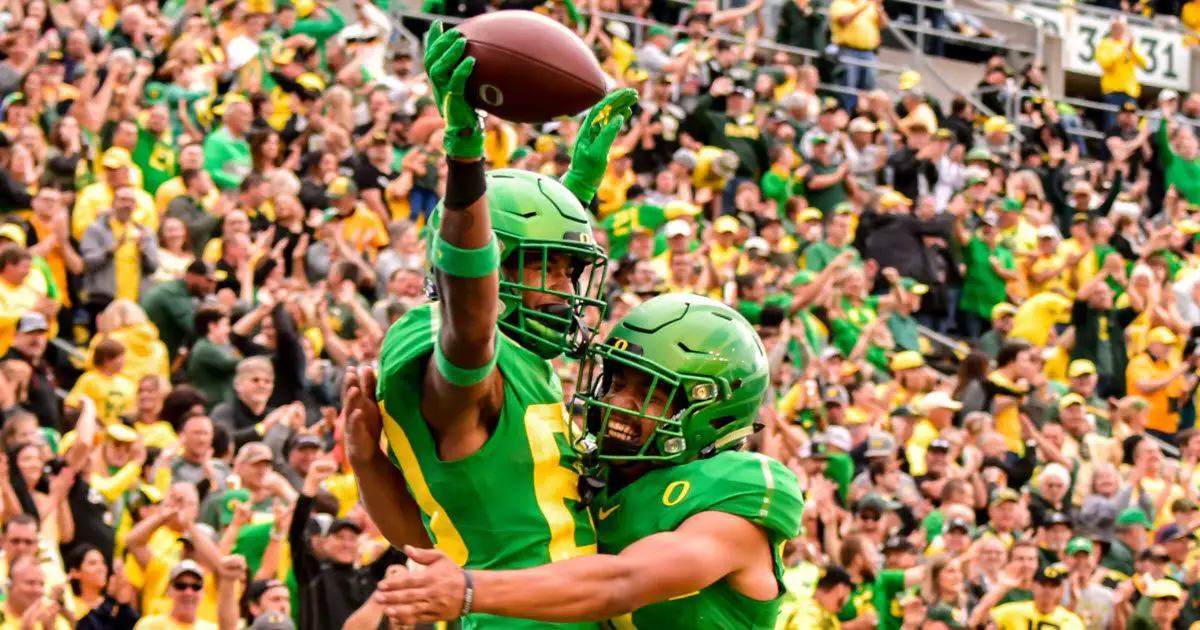Coach Mario Cristobal must have heaved a sigh of relief at halftime with the Ducks ahead of Nevada 35-6. Now, all his team needed to do was “finish” the job in the second half, which they did in resounding fashion, scoring 42 points and shutting out a Wolf Pack team that scored 34 the week before against a Big Ten team.
This week, quarterback Justin Herbert was unimpeded by conservative play calling, wide receivers were instructed to go deep, and the results were shocking to Nevada. Herbert was 19-of-26 passing for 310 yards and five touchdowns, 14 different players caught passes, and seven different receivers caught touchdown throws. Oregon was also able to rush for 221 yards, with five players having a gain of 10 or more yards on one play. The whole deal was dramatically different than the performance the week before.
The Duck pass rush came on strong, and some of the young bucks we’ve been hearing about from the recruiting wars jumped into the spotlight. The defense did not allow a touchdown, even after having to come on the field twice deep in their own end. There is a lot of speed and athleticism in the Duck defensive huddle, and it showed prominently in shutting down Nevada’s offense.
Nevada’s punter kicks a 56-yard punt that bounces short of the end zone and is considered un-catchable by punt returner Jevon Holland (No. 8).
In the case of a short punt, the return man (above) is responsible for letting those teammates who are setting up to block know that the ball is short and will not be caught, so they need to forget about their blocking responsibility and look up to see the ball.
It does not look like Holland is attempting to let Haki Woods (No. 12) know the situation; either that, or Woods is not listening. The ball hits Woods in the legs, which makes it a live ball. The Nevada player recovers the ball and heads for the end zone, but the ball is ruled dead where he recovered it. In this case, it is a muffed punt — which means that it was never possessed by the return team and cannot be advanced after the covering player recovers it. A fumbled punt (originally caught, or possessed) may be advanced, but not a muff.
This put the Ducks in an early hole, but the defense held firm inside the five-yard line and forced a field goal. This same situation occurred last year in the Ducks’ dismal showing at Arizona. It speaks to the necessity of communication between players on a kicking play on a critical part of the field. When this situation happens on a team’s sideline, everybody should be yelling, “Peter, Peter,” which is the universal warning for, “Short kick — find it, get away, don’t let it touch you.”
After missing badly on several deep balls in the first quarter, Herbert finds his touch, and tight end Jacob Breeland (No. 27), open on a wheel route for a 66-yard touchdown — Herbert’s 30th straight game with a scoring pass.
The play is set up by the slot to the right running a deep post over the middle, with Breeland running a circle route behind him. The safety in the middle is all of the sudden facing two deep threats coming at him and he falls, attempting to pivot and cover Breeland. Herbert is on the money and the tight end shows good speed in outracing the secondary for his eighth career touchdown catch.
This is a great example of the pressure the Ducks and Herbert can put on a defensive secondary when the coach calls a play deeper than 10 yards.
Facing a fourth down, the Wolf Pack brazenly go for it with a pass across the middle, which is wide open because the defender covering the slot is aligned too far off the receiver, conceding the first down. Oregon’s middle safety has also dropped deep to cover a potential punt and is not in position to help defend a pass.
Dropping the safety out of the middle may be a mistake, because if there is a punt it won’t be returned and the Ducks are going to have poor field position anyway. With 11 yards to go for a first down, Oregon would be better off defending the play tighter, preventing the fourth-down conversion and having better field position.
The safety covering the play, Verone McKinley III, is playing off, but reacts quickly and makes an excellent tackle, though too late to prevent the first down.
Nevada is going with a tempo offense right before halftime. The quarterback drops to pass, but a poor job of picking up a standard pass rush stunt ends up with a sack for DJ Johnson (No. 7) a 6-5, 272-pound sophomore transfer from Miami. The stunt is initiated by Johnson taking a hard rush inside the right tackle, who is in poor position and pad level to take anything off Johnson’s rush.
Drayton Carlberg (No. 90), a 6-5, 291-pound senior, playing defensive tackle, engages the right guard and then drops a bit to go around him and outside the offensive tackle who is turned, attempting to block Johnson. The guard runs into the tackle and compounding the mess, the center turns out to help and creates a pile. This is a classic example of a defensive stunt that destroys man-to-man pass blocking. Many teams would zone block this to prevent colliding with each other while trying to stay with a particular rusher.
Johnson is coming so strong, no one can stop him, and the Ducks have one of their five sacks for the game. The pass rush was anemic last season, but with better, quicker athletes and one of the best defensive line coaches in football in Joe Salave’a, things are looking up for Oregon.
QB Tyler Shough, backup to Herbert, was able to play the last quarter-and-a-half of the ball game and looked impressive. He was 8-of-9 passing and rushed for 11 yards with two scoring passes. In this situation, he hits Hunter Kampmoyer (No. 48) for a touchdown with the same kind of seam pass that Herbert had been converting.
Five different tight ends caught passes, including a one-yard strike from Herbert to Brady Aiello (6-7, 311 pounds), who is usually lined up as a tackle or guard in a offensive lineman’s numbered-jersey (No. 66). The offensive formation must always have five linemen who wear jerseys numbered from 50-79, which makes them ineligible pass receivers.
Aiello changed to an eligible number (to No. 82) before his big moment in the Autzen end zone, to the absolute delight of his teammates.
The Ducks take on Montana this Saturday evening. The challenge for Cristobal and his ballers will be to maintain the enthusiasm and energy they showed against Nevada. The coach talked a lot about “finishing” and his players took heart, at least by observation of the Nevada massacre.
Whether it’s Montana, or Stanford the week after, “finishing” is what good teams do all the time, and that’s the lesson that must be stressed every day in every way.
Coach Ken Woody
Eugene, Oregon Top Photo by Kevin Cline
Want to learn from Coach Woody in person? He will be analyzing the prior game each week this season at the 6th Street Grill in Eugene on Wednesdays from 6:00 to 7:30 PM with video analysis and opening it up for questions. Join him and learn more football! Charles Fischer

Natalie Liebhaber, the FishDuck.com Volunteer Editor for this article, works in the financial technology industry in Bozeman, Montana.
Dan Fouts, NFL Hall of Fame, Oregon Ducks quarterback: “Entertaining and easy to understand.”
“Every Oregon fan should have a copy to learn from as I do.” Charles Fischer
Buy the book here to learn from Coach Woody, or give a gift of football, a great gift for the fan who wants to learn and enjoy more of the Duck (or whoever your favorite team is) football experience.
Ken Woody is a former Fox Sports football commentator who played defensive back, receiver and kicker for Oregon from 1966 to 1970. He coached college football for 18 years, including stints as an assistant coach at Oregon, Washington, Washington State and Utah State, and was head coach at Whitman College and Washington University-St. Louis. He writes x’s and o’s, a weekly column in the Register-Guard, RG online coverage of Duck football and is the author of “After Further Review—an inside look at what’s really happening on the football field.” Woody is on KUGN (590 am) 2:45 before kickoff and 30 minutes after each game with coaching and game analysis.
Related Articles:
Ducks, Cristobal Answer Nagging Questions: Are the Ducks for Real?
Ducks Hang on in a Rough Ride with Fresno State
Cristobal: "Time to Coach 'Em Up"
"For Real"-Finally, Cristobal Unleashes Herbert in the Red Rose Zone
Coach Woody Analysis: Run Game Evolution and Opportunistic Defense Stun Utes
Coach Woody Analysis: Ducks Need More than the Pistol to Beat Utah
“I learned football working under many great coaches, among them Len Casanova, Jerry Frei, John Robinson, Bruce Snyder, George Seifert,and Ron Stratten at the University of Oregon, Jim Owens at the University of Washington and Jim Walden at Washington State University. Most of my coaching experience was on the offensive side of the ball with quarterbacks, receivers and kickers although as a head coach I coached defensive backs, linebackers and offensive line.
I achieved my first goal of being the youngest head coach in college football at the age of 26 and throughout my career in coaching and outside of it, as a journalist and broadcaster, have experienced how exciting and gratifying it is teaching the game to others.”


